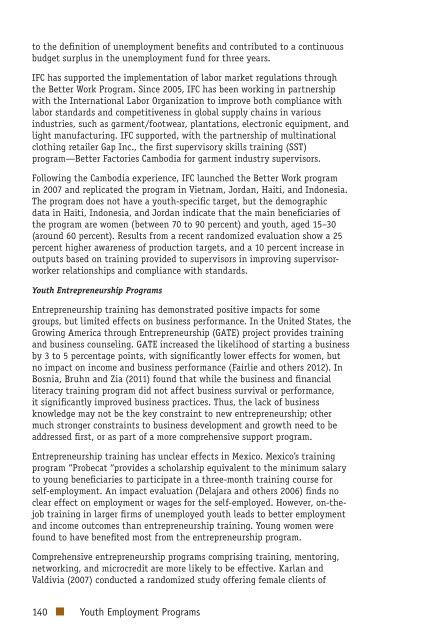Youth Employment Programs - Independent Evaluation Group
Youth Employment Programs - Independent Evaluation Group
Youth Employment Programs - Independent Evaluation Group
Create successful ePaper yourself
Turn your PDF publications into a flip-book with our unique Google optimized e-Paper software.
to the definition of unemployment benefits and contributed to a continuousbudget surplus in the unemployment fund for three years.IFC has supported the implementation of labor market regulations throughthe Better Work Program. Since 2005, IFC has been working in partnershipwith the International Labor Organization to improve both compliance withlabor standards and competitiveness in global supply chains in variousindustries, such as garment/footwear, plantations, electronic equipment, andlight manufacturing. IFC supported, with the partnership of multinationalclothing retailer Gap Inc., the first supervisory skills training (SST)program—Better Factories Cambodia for garment industry supervisors.Following the Cambodia experience, IFC launched the Better Work programin 2007 and replicated the program in Vietnam, Jordan, Haiti, and Indonesia.The program does not have a youth-specific target, but the demographicdata in Haiti, Indonesia, and Jordan indicate that the main beneficiaries ofthe program are women (between 70 to 90 percent) and youth, aged 15–30(around 60 percent). Results from a recent randomized evaluation show a 25percent higher awareness of production targets, and a 10 percent increase inoutputs based on training provided to supervisors in improving supervisorworkerrelationships and compliance with standards.<strong>Youth</strong> Entrepreneurship <strong>Programs</strong>Entrepreneurship training has demonstrated positive impacts for somegroups, but limited effects on business performance. In the United States, theGrowing America through Entrepreneurship (GATE) project provides trainingand business counseling. GATE increased the likelihood of starting a businessby 3 to 5 percentage points, with significantly lower effects for women, butno impact on income and business performance (Fairlie and others 2012). InBosnia, Bruhn and Zia (2011) found that while the business and financialliteracy training program did not affect business survival or performance,it significantly improved business practices. Thus, the lack of businessknowledge may not be the key constraint to new entrepreneurship; othermuch stronger constraints to business development and growth need to beaddressed first, or as part of a more comprehensive support program.Entrepreneurship training has unclear effects in Mexico. Mexico’s trainingprogram “Probecat “provides a scholarship equivalent to the minimum salaryto young beneficiaries to participate in a three-month training course forself-employment. An impact evaluation (Delajara and others 2006) finds noclear effect on employment or wages for the self-employed. However, on-thejobtraining in larger firms of unemployed youth leads to better employmentand income outcomes than entrepreneurship training. Young women werefound to have benefited most from the entrepreneurship program.Comprehensive entrepreneurship programs comprising training, mentoring,networking, and microcredit are more likely to be effective. Karlan andValdivia (2007) conducted a randomized study offering female clients of140 <strong>Youth</strong> <strong>Employment</strong> <strong>Programs</strong>
















